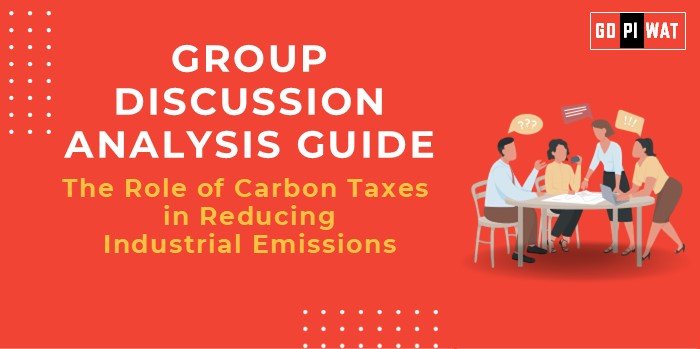📋 Group Discussion (GD) Analysis Guide: The Role of Carbon Taxes in Reducing Industrial Emissions
🌐 Introduction to the Topic
- Opening Context: Climate change is the defining challenge of our time. Governments worldwide are exploring mechanisms like carbon taxes to curb industrial emissions, given that industries account for nearly 30% of global greenhouse gas emissions.
- Topic Background: The concept of carbon taxes dates back to the 1990s, initially adopted by Nordic countries like Finland and Sweden. Today, with global warming intensifying, nations face renewed pressure to enforce stricter policies, including taxation, to encourage sustainability.
📊 Quick Facts and Key Statistics
- 🌍 Global CO2 Emissions: Industries contribute 23 billion metric tons annually, accounting for 29% of global emissions (IEA, 2023).
- 📜 Carbon Pricing Schemes: Over 70 jurisdictions now implement carbon taxes or cap-and-trade systems (World Bank, 2023).
- ✅ Successful Case: Sweden levies $137 per ton of CO2, reducing industrial emissions by 25% since 1991.
- 💰 Economic Impact: Countries with carbon taxes witness economic shifts towards renewable energy industries.
🤝 Stakeholders and Their Roles
- Governments: Design tax policies and reinvest revenues into green technology.
- Industries: Major emitters required to innovate or pay higher taxes.
- Citizens: Consumers facing potential cost shifts due to industrial compliance costs.
- NGOs/Think Tanks: Advocate for fair policies and monitor effectiveness.
- Global Agencies: Support international cooperation and provide climate-related data.
🏆 Achievements and Challenges
✨ Achievements
- 🌱 Sweden: 25% reduction in industrial emissions with GDP growth unaffected.
- 🇪🇺 EU: €50/ton tax encouraging renewable energy adoption.
- 🇨🇦 Canada: Generated $5.6 billion in revenue, reinvested in sustainable projects.
⚠️ Challenges
- 💸 Economic Impact: Industries pass costs to consumers.
- 🌍 Global Inconsistency: Tax levels vary drastically, leading to “carbon leakage.”
- 🛠️ Innovation Lag: High initial costs for green alternatives slow adoption.
Global Comparisons: Sweden leads in carbon taxation, while the U.S. faces resistance. Countries like China use hybrid models of regulation and incentives.
📖 Structured Arguments for Discussion
- ✅ Supporting Stance: “Carbon taxes incentivize industries to adopt cleaner practices, ensuring long-term environmental and economic health.”
- ⚡ Opposing Stance: “Higher taxes on industries risk economic stagnation and disproportionately affect small-scale industries.”
- ⚖️ Balanced Perspective: “While carbon taxes promote sustainability, governments must balance environmental goals with economic stability.”
💡 Effective Discussion Approaches
📣 Opening Approaches
- 📊 Highlight recent data: “Industries contribute nearly 30% of global CO2 emissions—how do we address this effectively?”
- ❓ Pose a problem: “Carbon taxes could either save our planet or strain economies—where should we draw the line?”
🛡️ Counter-Argument Handling
- 🌟 Recognize concerns of economic slowdown but suggest reinvestment into green tech.
- 📖 Offer examples of successful policies like Sweden’s or Canada’s models.
🛠️ Strategic Analysis of Strengths and Weaknesses
- Strengths: Proven impact on emissions reduction, drives green innovation.
- Weaknesses: Risk of carbon leakage, potential for economic disparities.
- Opportunities: Global collaborations (e.g., Paris Agreement goals), boost for renewable sectors.
- Threats: Public backlash against higher costs, industry relocation to low-regulation zones.
🔗 Connecting with B-School Applications
- Real-World Applications: Relevant for courses in sustainability management, operations, and finance.
- Sample Interview Questions:
- “How can carbon taxation support ESG (Environmental, Social, Governance) goals?”
- “Can taxation drive innovation or hinder industrial growth?”
- Insights for B-School Students:
- Carbon policies shape business models.
- Industries face growing pressure for transparent carbon accounting.


